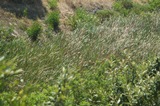Weaver species
Choose different species from drop-down list and press 'Go' button. See Full species list.Seychelles Fody Foudia sechellarum
IUCN: Near threatened Discovery: 066Categories: white eggs, island, Foudia, fruit, IUCN, nectar, palm,
News items about species
Discovery
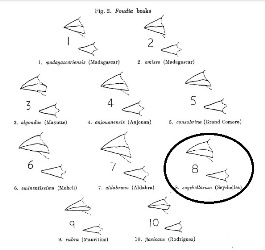
figure from Moreau (1960) 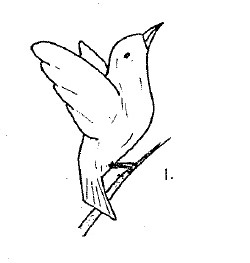
figure from Crook (1961) 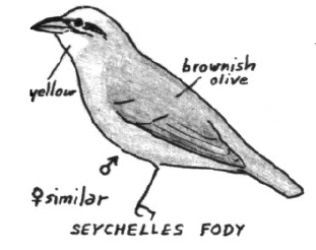
figure from Watson (1963) 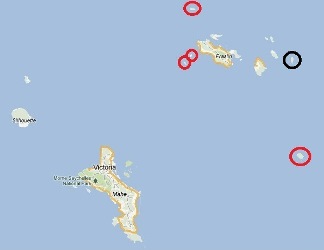
type locality circled in black IntroductionThe Seychelles Fody was formally described by Edward Newton, a British colonial administrator and ornithologist. Newton was the Colonial Secretary for Mauritius from 1859 to 1877. In Jan-Feb 1866 he visited the Seychelles.On 12 February 1866, Newton landed on Marianne Island, looking for a bird known on that island as "Le Mangeur de riz" (French for Rice Eater). This bird turned out to be the Seychelles Fody. Newton shot three specimens which are now in the museum in Cambridge. Newton also observed some fifty to a hundred similar dull coloured birds on the island, and wrote:
By 1961 the Seychelles Fody was found to be extinct on Marianne. The first illustration pertaining to Seychelles Fody was of the bill shapes of different fody species by Moreau (1960). The next illustration was a line drawing of displaying male by Crook (1961). Possibly because the Seychelles Fody is the least colourful of all the fodies, there was a long interval between description and first illustrations. The first time all the fodies were illustrated was by Watson (1963), although these were line drawings (not colour) for identification purposes. Colour photos and paintings of the Seychelles Fody start appearing in the 1970s. Scientific citationFoudia sechellarum Newton 1867, Proc. Zool. Soc. London, p.346, Marianne Island.Meaning of namessechellarum After the Seychelles Islands (Republic of Seychelles).First English nameSeychelles Fody (Shelley 1905).Alternate namesToc-toc.CollectorEdward Newton.Date collected12 Feb 1866Locality collectedMarianne Island, Seychelles.Type specimensThere are 3 syntype specimens in at Cambridge (Cambridge 27/Plo/6/f/1-3) where Alfred Newton was based. |
The above is based on Weaver Wednesday 2, a weekly series about the discovery of each weaver species.
This species text first appeared as
Weaver Wednesday [183] - Discovery [66]: Seychelles Fody on 2015-12-16
1. Basic biology
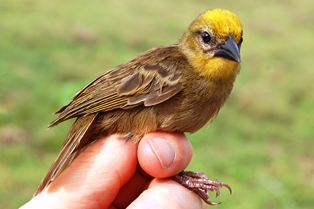
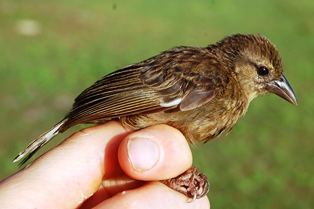
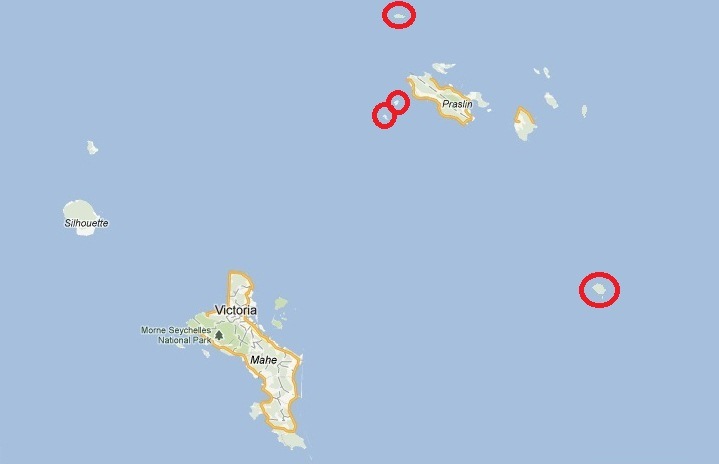
Distribution. The Seychelles Fody is present on six islands: Cousin, Cousine, Fregate, Aride (reintroduced in 2002), d'Arros (introduced in 1965) and Denis (introduced 2004). The map above shows some of these islands circled in red; d'Arros is far to the left off the map, and Denis far to the north. Before European settlement it was probably widely distributed in the Seychelles, but only confirmed from Marianne, Cousin, Cousine and Fregate. By the 1940s it was extinct on Marianne. The increase in the Cousin lsland population, and successful reintroduction to Aride and Denis lslands resulted in the fody being downlisted from Vulnerable to Near threatened. Habitat. The Seychelles Fody inhabits highly modified habitats such as human settlements, coconut and Casuarina plantations, and other exotic vegetation types. Originally it was probably restricted to native humid forest, in which it still occurs on Cousin and Aride, including hill and marsh areas. Food.
The toc-toc is mainly insectivorous but also feeds on seed, fruit and nectar. It may be unique among weavers in its habit of rarely feeding on the eggs of seabirds.
Breeding. The Seychelles Fody is a socially monogamous weaver. The peak breeding season, between May and October, coincides with the southeast monsoon or dry season but toc-tocs may breeding all year round. One, but more often two eggs are laid in a globular, enclosed, woven nest (photo left) and incubation is done entirely by the female. Both sexes participate in nest building, nestling and fledgling care. After fledging, parents attend their young for an average of 12 weeks, much longer than in other weavers. An interesting study found post-fledging brood division between the sexes on Cousin, i.e. the parent male feeds male fledglings and the parent female feeding male fledglings; single fledglings are cared for only by the female parent; in the few observed broods with 2 female offspring, the male parent cares for one of them. Nest predators that have been recorded are: gecko, Wright's Skink, Seychelles wolf snake, and Common myna. See a video clip of the antics of a pair of Seychelles Fodies collecting nest material here. The oldest known Seychelles Fody is at least 14 years old (see here). |
The above is based on Weaver Wednesday, a weekly series about weaver species.
This species text first appeared as
Weaver Wednesday [4]: Seychelles Fody on 2012-07-11
2. Breeding facts
| Pair bond Monogmous; pair-members remain together for several consecutive seasons Breeding season May-Sept with clearly defined moult and breeding seasons, on Cousin; has been suggested also that breeding occurs throughout year, with no fixed season, individuals sometimes nesting at intervals of more than 12 months Nest site supported by twigs (rather than supended) at 2-25 m above ground in tree Nest building built mostly by male but female contributing throughout Colony size no information Clutch size 1-2 eggs Egg colour pure white Egg size average size of nine eggs 18.7 x 14.5 mm Incubation incubation by female only, period 14 days Chicks and nestling period chicks fed by both parents, both by regurgitation and with insects brought in beak, no information on duration of nestling period |
Breeding information based on Handbook of the Birds of the World, Vol. 15.
3. Photos of Weaver Nests
 Vm 26676 |  Vm 8889 |  Vm 1939 |  Vm 1258 |
Thumb-nails of most recent PHOWN records - click on one to see its full record
See all PHOWN records for this species here.
PHOWN (Photos of Weaver Nests) provides valuable info on breeding distribution and colony sizes of weavers.
You can contribute by registering and submitting photos at Virtual Museum webpage.
4. Breeding distribution
Google map showing distribution (For species with small ranges you need to zoom in at the correct area to see the range):
yellow blob - range of weaver species; read more about this here.
![]() - PHOWN records with photos
- PHOWN records with photos
![]() - PHOWN records with no photos (Nest Record Cards, other records)
- PHOWN records with no photos (Nest Record Cards, other records)
![]() - Birdpix records
- Birdpix records
![]() - comments on out of range records, or interesting records
- comments on out of range records, or interesting records
![]() - type locality
- type locality
CLICK on the marker on the map to see individual record details.
5. Range changes
Not South African speciesThe above is based on Weaver Wednesday 3, a weekly series about range changes in South African weaver species.
This species text first appeared as
n/a








